Sometimes the world slips through the window and joins us where we live. And, of course, the more fully we live, the more often it joins us.
In December 1991, in the final sprint to finish my first big book, I found myself becoming more alert than usual. It was my first experience with the white-hot stage of sustained composition and the state of heightened attention that makes the world outside and the world of the imagination come together in strange and magical ways. Similar conjunctions have occurred with every book I’ve written, but this was the most vivid of them.
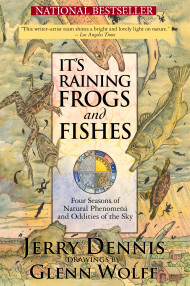 It was a book about wonders of the sky, and to see those wonders all I had to do was step outside and look up. Writing about sunsets and meteor showers and snowflakes and birds in flight made me unusually aware of them. I’ve been chasing that level of awareness ever since.
It was a book about wonders of the sky, and to see those wonders all I had to do was step outside and look up. Writing about sunsets and meteor showers and snowflakes and birds in flight made me unusually aware of them. I’ve been chasing that level of awareness ever since.
The first complete draft of It’s Raining Frogs and Fishes: Four Seasons of Natural Phenomena and Oddities of the Sky was nearing completion and I could finally see my way through to the end. For months I had been faxing rough drafts to artist Glenn Wolff, who would then sketch ideas for illustrations and fax them back and call to discuss them. Now he was finishing many of the 80-plus illustrations that would later appear in the book and would inspire reams of praise from critics and readers.
All that year our work seemed like a magnet for wonders. When we were working on the chapter about sunrises and sunsets, we saw night after night for a week the most brilliant sunsets we’d ever witnessed, the result of a volcanic eruption in the Philippines that cast vast clouds of dust into the upper atmosphere and tinted the setting sun shades of vivid scarlet and purple. I saw one sunset so astonishing — not only brilliant with colors, but expanding across most of the sky — that it made traffic on a busy highway I was driving along come to a virtual halt. Late one night Glenn stepped outside his studio after working on the illustration for the aurora chapter, and looked up to see the Northern Lights of a lifetime. He called me and said, “Go outside, right now, and look up.” I stepped out the door, then hurried back inside and woke my sons and wrapped them in blankets and took them outside to the yard. The aurora filled the sky, beams of light radiating from a central spot almost straight overhead, pulsating in curtains of red, pink, and green. I have never seen a more brilliant display.
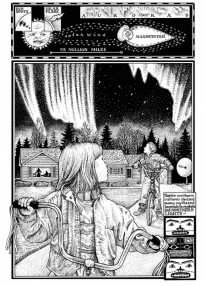 By December Glenn and I were working twelve or more hours a day, seven days a week to meet our publisher’s deadline. Much of the month I was working virtually around the clock, sleeping and writing in the same room, taking catnaps when necessary, often losing track of time or even whether it was day or night. When I took breaks, it was to read in bed or go for walks outside.
By December Glenn and I were working twelve or more hours a day, seven days a week to meet our publisher’s deadline. Much of the month I was working virtually around the clock, sleeping and writing in the same room, taking catnaps when necessary, often losing track of time or even whether it was day or night. When I took breaks, it was to read in bed or go for walks outside.
My days turned even crazier when Gail and I sold our house on Eleventh Street and had to vacate it the last week of November, nearly a month before our house on Old Mission Peninsula would be ready for us. My parents came to the rescue and invited us to move in with them in their house on Long Lake — the house where I had lived for much of my childhood and adolescence, and about which I had begun writing the essays that would appear a couple years later in A Place on the Water. For Aaron and Nick, who were 12 and 4 that December, it was a grand adventure — a month of slumber parties with Grandma and Grandpa — and they couldn’t have been happier. It turned out to be a grand adventure for all of us.
Below is an excerpt from the journal I kept during those years. I will always look back upon that winter of wonders as one of the richest and most rewarding periods of my life.
12/1/91 — Walked to Bullhead Lake with Gail and the kids. Day clear and sunny and very cold. The lake freshly frozen, the ice clear and a quarter-inch thick, etched on the top with crystal patterns, like it had been spread with a broad plaster knife. Thousands of tiny snow fleas (Boreus hyemalis?) hopped methodically, three inches at a leap, away from shore on the ice. Each, when it landed, adjusted for direction before leaping again in a surprisingly straight course out from shore. Where were they headed? Through the ice, as visible as if seen through glass, were water boatmen and other aquatic organisms moving around among the decomposing leaves on bottom. The woods are snow-free after the fohn-like winds of last week, but the leaves are frozen into crunching mats, and the temperature now is cold enough to burn your face and ears. Glove weather. Aaron and Nick are always enervated by a walk in the woods.
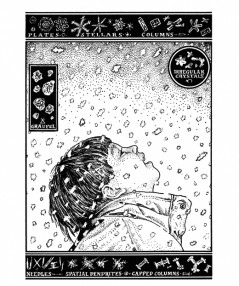 Hard to get back into the book after the three days off to move. Worn out the first day or two; simply lazy now. Would prefer to nap and read novels and daydream. Language lacks importance. Strange to be in the house of my childhood. I’ve commandeered a bedroom for my office, and sleep alone in it. Best that way, I think, since I expect to re-catch the fever soon and be working late nights again.
Hard to get back into the book after the three days off to move. Worn out the first day or two; simply lazy now. Would prefer to nap and read novels and daydream. Language lacks importance. Strange to be in the house of my childhood. I’ve commandeered a bedroom for my office, and sleep alone in it. Best that way, I think, since I expect to re-catch the fever soon and be working late nights again.
12/2 — Another very cold day. Gray stratus has us locked into a colorless and dreary world. The lake this morning was partially frozen, especially on this lee shore between here and the island. Some of the new ice was coated with a fine dusting of snow crystals, the kind that materializes out of clear sky. Had to dust off the car this morning, and scrape the frost. Wind came up by mid-morning and the ice 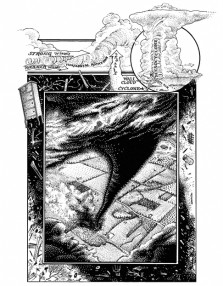 disappeared. Another night or two as cold as last night and the entire lake will skim over, then the wind won’t be able to slip beneath the ice to break it up. Now I’m alone in the house and still can’t get my passion back for the book. Worked some on tornadoes and hurricanes, but can’t seem to get fired up in spite of dangerously near deadline. Need to back into it slowly and surprise myself. Work on something that seems easy. Do busy work until I can dig in and compose again.
disappeared. Another night or two as cold as last night and the entire lake will skim over, then the wind won’t be able to slip beneath the ice to break it up. Now I’m alone in the house and still can’t get my passion back for the book. Worked some on tornadoes and hurricanes, but can’t seem to get fired up in spite of dangerously near deadline. Need to back into it slowly and surprise myself. Work on something that seems easy. Do busy work until I can dig in and compose again.
12/3 — Woke to a white world. Snow made fine by the cold; drifts to three or four feet. School closed. The lake unfrozen, no doubt because of the strong winds all night — open water looks peculiar when surrounded by snowy landscapes. Excitement of the unusual, unexpected. The day the color of a black-and-white print in excellent focus.
12/9 — Crazy salad days. Blitzing on the book now; not far from having all the first drafts finished. The rest will be relatively easy. Worked nearly 17 hours Saturday and finished two chapters. Working long days and nights, sleeping late (when I can), piling words upon words upon words.
The weather has been bizarre, though I’ve had little time to be out in it. The view from the picture window here has been interesting: Last week the lake froze entirely, then snow covered it with enough weight to streak it with cracks that soaked through and looked like snowmobile tracks. Everyone thought it was here to stay, and that, like most years, we would have heavy snow cover before the ice had a chance to firm up solid. Then, the sixth, thaw: overnight the snow on the lake puddled to a continuous layer of water over the clear ice (we could see through it to bottom even from the house). Then, the seventh, rain and warm wind. By the eighth the lake broke open again, all the ice except some shore piles melted, most of the snow gone. Today it’s clear and sunny, 40 degrees, breeze from the west, and the driveway is damp gravel and the yard has patches of open areas. If this holds until we move on the 18th I’ll be a grateful guy.
I love this stage of a book. I’m so engaged in composition that I experience a psychological equivalent of continental drift: subterranean plates are shifting, grinding one another, and something that lies beneath, something vaguely sensed, threatens to come visible. I’m in a continuous state of mild excitement, with moments of intense excitement and lucidity. Everything seems possible; no project is beyond my abilities. It seems now it would be the easiest thing in the world to sit down and compose fiction — and a relief, not having to worry about getting the facts right. If this confidence lasts beyond the completion of the book I want to begin work in January on a series of new stories. And a series of nature essays. And a novel…
12/13/91 — Stealing a few minutes from 2:20 AM. Buried to the eyebrows. Don’t know if I will finish the book on deadline or not — don’t know anything. Paul Bowles notes the difference between a diary (things that happened) and a journal (what I think about the things that happened), but I don’t know whether it applies to real life. Watched three otters this morning diving and swimming out front. They came to shore finally, swimming underwater even in the very shallow water, then climbed up on the bank and nosed around for awhile. Very sociable with one another, always close, frequently touching and rubbing. They took turns rubbing their backs and sides on patches of snow; if there had been more on the bank perhaps they would have slid. They seem extremely confident creatures — superb at what they do best — so efficient in the business of getting around and getting enough to eat that they have leisure to do it beautifully and leisure to be inquisitive. Hard to tell from our vantage in the house (Gail and Mom watched too, and we were all sorry that the kids weren’t here), but they may not have been quite full-grown. All were similar is size (though one may have been slightly larger than the other two — they did not stay still long enough to give much opportunity for comparison) which made me suspect they are siblings. They took their time getting back in the water, then porpoised away to the drop-off. At one spot between Johnson’s and Menzel’s, maybe 30 feet out from the drop-off, they dove repeatedly for perhaps 10 minutes, often coming up and making chewing motions. I’m sure they were feeding, but could not see on what, even with binoculars. Not fish. That’s what happened. I don’t know what I think about it. Yes I do: I think the otters traveled up the creek from Lake Dubbonnet and only visit Long Lake in late fall because Long Lake in the summer is full of power boats and is an unhealthy place for otters. And I think it is mighty intelligent of them to know it.
Weather continues strangely mild. Steady rain much of today. Forecast is for freezing rain tonight and snow tomorrow, then cold and snow forever. The lake is so anxious to freeze it produces thin plates of ice in spite of the mild temperatures, then the wind breaks them into slivers that gather in odd loose slush-like aggregations for 10 or 20 feet out from the windward shore. The waves are sharply ruffled until they reach the layer of slush, then are soothed, like a blanket laid over a troubled child. The wind has blown from several directions this week, which I suspect means we’re in for stormy weather. It was from the southeast this morning, then from the west this afternoon. We’re in for it.
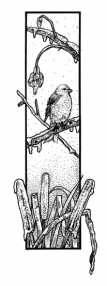 12/14 — Woke up to snow on the ground and it has been snowing continuously and in increasingly heavy amounts all day. Now, late afternoon, we’re in mild blizzard conditions, with visibility reduced enough to obscure the far shore of the lake, and the island at times, and accumulations of six inches or so on the ground. The wind, gusting from the north, has kept the lake from freezing, and the lake looks like it doesn’t like the idea one bit. It looks like winter is thumping its heavy way in for good. Just in time for moving day Wednesday. After two weeks of non-stop work on the book I had to take a break yesterday afternoon and found myself incapable of doing much but watching television basketball. Recovered the juice about 1:30 AM, worked for an hour, then went to sleep and woke up refreshed and ready to hit it today. Clubbing away….
12/14 — Woke up to snow on the ground and it has been snowing continuously and in increasingly heavy amounts all day. Now, late afternoon, we’re in mild blizzard conditions, with visibility reduced enough to obscure the far shore of the lake, and the island at times, and accumulations of six inches or so on the ground. The wind, gusting from the north, has kept the lake from freezing, and the lake looks like it doesn’t like the idea one bit. It looks like winter is thumping its heavy way in for good. Just in time for moving day Wednesday. After two weeks of non-stop work on the book I had to take a break yesterday afternoon and found myself incapable of doing much but watching television basketball. Recovered the juice about 1:30 AM, worked for an hour, then went to sleep and woke up refreshed and ready to hit it today. Clubbing away….
12/16 — Fighting the flu or something. Could sleep and sleep and sleep. The lake froze over last night, during a fairly heavy snow, so that today it is white and slushy already, with continental outlines of black where it has cracked. Still a wide area of open water to the northeast of the island, but everywhere else it is frozen. At leave 12 inches of snow on the ground. Went out long enough today to catch snow crystals on my jacket sleeve, then had to return to bed. Picking away at random paragraphs on the book. Too weak to care about deadlines. Mixed in with the lethargy of illness come moments of elation, even spurts of creativity. Might have written a poem yesterday, the first in months. Instead of sleeping at night I’m reading all the 1987 issues of Antaeus and Paris Review. In the midst of a lot of intellectual weight-lifting and pompous posing, some brilliant essays and stories, notably by William Kittridge and Donald Hall. Otherwise, much self-important wheezing. Donald Hall says reading should be done with the tongue and mouth, and that most critics read only with their eyes.
Saw a pair of pileated woodpeckers flying overhead one afternoon last week. They seemed too heavy for flight, as if their bones were solid. Between each wing stroke they plummeted, rose when they beat, then plummeted — if they had missed a stroke they would have fallen to the ground like hatchets.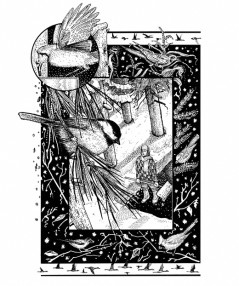
Up against the usual dualities. I want to dedicate my life to literature, but after two or three days of hard work I long to be with the kids outside, free of language; outside I soon long for the intimacy of my desk, a pool of yellow lamplight, and a stack of notebooks. Can neither be satisfied just living nor just reacting to living. Want both, somehow, simultaneously. In the act of writing I feel most alive, but it’s not enough. I want to carry the intensity of creation to the ordinary moments of existence. I want meaning to adhere to experience, but don’t want to intellectualize experience. The solution perhaps is to cultivate a moderate level of mania: one in which my judgment is not distorted, and from which the fall to the ground is not crippling. Can I sustain such a level for a solid month?


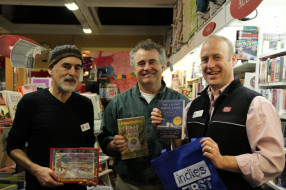


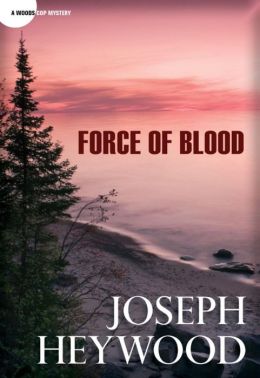

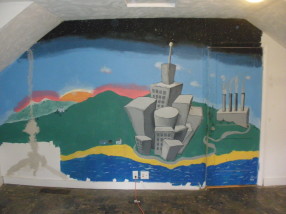


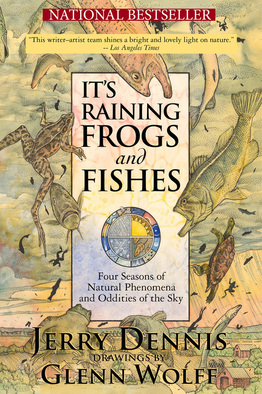
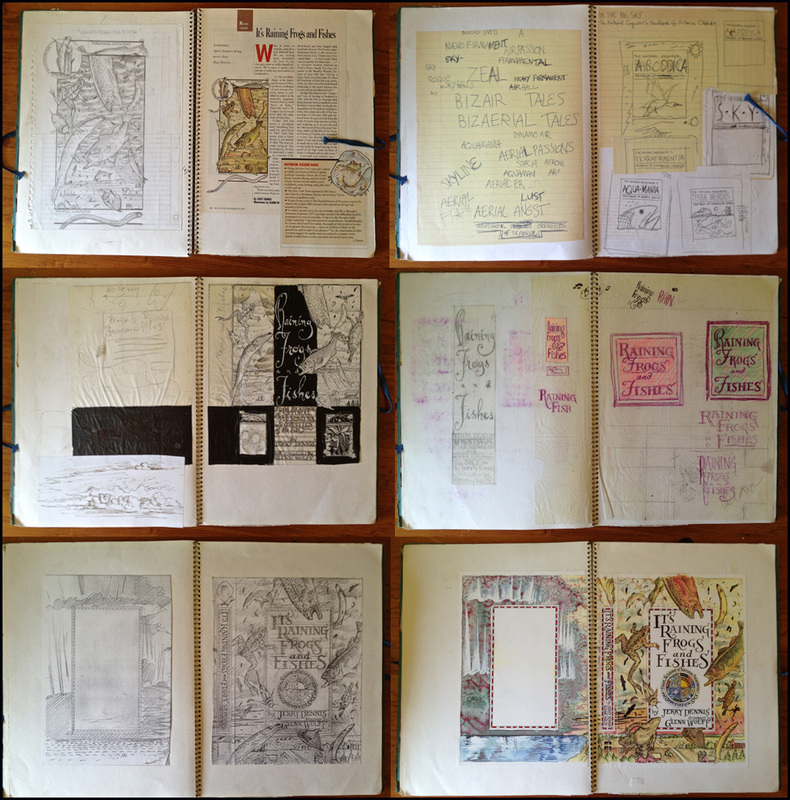
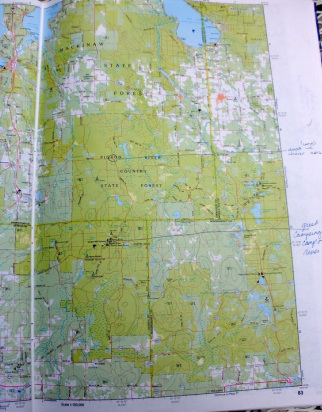 Here’s what turns my crank: Free-flowing rivers in wild country, ponds hidden in tamarack swamps, campsites under white pines swaying in a breeze, trout gulping mayflies. I like pushing off in a canoe. I like slinging a backpack onto my shoulders. I like knowing that if I find a woods or a pond or a stretch of river that suits me I can stay put for a few days or a week. And I like going my own way, at my own pace, and stumbling upon beautiful and interesting places.
Here’s what turns my crank: Free-flowing rivers in wild country, ponds hidden in tamarack swamps, campsites under white pines swaying in a breeze, trout gulping mayflies. I like pushing off in a canoe. I like slinging a backpack onto my shoulders. I like knowing that if I find a woods or a pond or a stretch of river that suits me I can stay put for a few days or a week. And I like going my own way, at my own pace, and stumbling upon beautiful and interesting places.
7 Replies